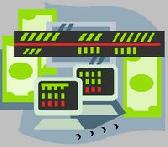
 |
|
| Financial Terms | |
| business process reengineering (BPR) |
|
Information about financial, finance, business, accounting, payroll, inventory, investment, money, inventory control, stock trading, financial advisor, tax advisor, credit.
Main Page: accounting, credit, money, payroll, finance, financial advisor, stock trading, inventory control, |
Definition of business process reengineering (BPR)
business process reengineering (BPR)the process of combining information technology to create new and more effective
Related Terms:Basic business strategiesKey strategies a firm intends to pursue in carrying out its business plan. Business cycleRepetitive cycles of economic expansion and recession. Business failureA business that has terminated with a loss to creditors. Business riskThe risk that the cash flow of an issuer will be impaired because of adverse economic Corporate processing floatThe time that elapses between receipt of payment from a customer and the Diffusion processA conception of the way a stock's price changes that assumes that the price takes on all In-house processing floatRefers to the time it takes the receiver of a check to process the payment and  Price discovery processThe process of determining the prices of the assets in the marketplace through the Process costingA method of costing for continuous manufacture in which costs for an accounting compared are compared with production for the same period to determine a cost per unit produced. business intelligence (BI) systema formal process for gathering and analyzing information and producing intelligence to meet decision making needs; requires information about business-value-added activityan activity that is necessary for the operation of the business but for which a customer would not want to pay cost-benefit analysis the analytical process of comparing therelative costs and benefits that result from a specific course FIFO method (of process costing)the method of cost assignment that computes an average cost per equivalent Internet business modela model that involves joint processa manufacturing process that simultaneously modified FIFO method (of process costing)the method of cost assignment that uses FIFO to compute a cost per  multiprocess handlingthe ability of a worker to monitor process benchmarkingbenchmarking that focuses on practices and how the best-in-class companies achieved their results process complexityan assessment about the number of processes through which a product flows process costing systema method of accumulating and assigning costs to units of production in companies producing large quantities of homogeneous products; processing timethe actual time consumed performing the process mapa flowchart or diagram indicating every step process productivitythe total units produced during a period process quality yieldthe proportion of good units that resulted from the activities expended product- (or process-) level costa cost that is caused by the development, production, or acquisition of specific products or services statistical process control (SPC)the use of control techniques that are based on the theory that a process has natural variations in it over time, but uncommon variations strict FIFO method (of process costing)the method of cost assignment that uses FIFO to compute a cost per equivalent unit and, in transferring units from a department, keeps the  weighted average method (of process costing)the method of cost assignment that computes an average cost per Ito processStatistical assumptions about the behavior of security prices. For ProcessA series of linked activities that result in a specific objective. For example, the Process costingA costing methodology that arrives at an individual product cost through the calculation of average costs for large quantities of identical products. Work-in-process inventoryInventory that has been partially converted through the operating risk (business risk)Risk in firm’s operating income. Business CycleFluctuations of GDP around its long-run trend, consisting of recession, trough, expansion, and peak. Political Business CycleA business cycle caused by policies undertaken to help a government be re-elected. Real Business Cycle TheoryBelief that business cycles arise from real shocks to the economy, such as technology advances and natural resource discoveries, and have little to do with monetary policy. Purchased In-Process Research and DevelopmentUnfinished research and development that is acquired from another firm. Process flow productionA production configuration in which products are continually Reprocessed materialMaterial that has been reworked and returned to stock. Work-in-processAny items being converted into finished goods or released from Business Expansion InvestmentThe use of capital to create more money through the addition of fixed assets or through income producing vehicles. High-Risk Small BusinessFirm viewed as being particularly subject to risk from an investors perspective. Commercial Business Loan (Credit Insurance)An agreement between a creditor and a borrower, where the creditor has loaned an amount to the borrower for business purposes. Related to : financial, finance, business, accounting, payroll, inventory, investment, money, inventory control, stock trading, financial advisor, tax advisor, credit. |